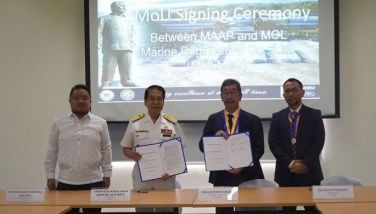The biggest threats

In the administration of the only son of Corazon Aquino, coup attempts and political instability have become “remote threats” to business, according to a report prepared by a business risk consultancy.
That should be good news for us. But what PSA or Pacific Strategies & Assessments considers to be the “most significant threats” to Metro Manila are earthquakes, typhoons and pandemics – and we are not prepared to deal with them.
PSA is a 10-year-old business risk consultancy whose managing director, Scott Harrison, is a former station chief of the US Central Intelligence Agency. Its director of business development, Stephen Cutler, headed operations of the US Federal Bureau of Investigation in the Philippines for five years.
The company provides, according to its website, “security consulting, crisis management, business intelligence, investigations, and background screening services” to financial institutions, insurance companies, professional service firms, multinational corporations, embassies, government agencies, international organizations and individuals doing business in Asia. The company has offices across the region.
PSA has given its clients an assessment of Metro Manila’s vulnerability to a major earthquake and its impact on business continuity.
The report is scary, and you’d wish the assessments were based on the same flawed science that recently cost Prisco Nilo his job as head of the Philippine Atmospheric, Geophysical and Astronomical Services Administration (PAGASA).
But this report is an updated one based on the 2004 Metro Manila Earthquake Impact Reduction Study (MMEIRS) conducted by the Japan International Cooperation Agency together with the Metro Manila Development Authority and the Philippine Institute of Volcanology and Seismology (Phivolcs).
Earthquake prediction is even more imprecise than PAGASA’s storm tracking. Phivolcs does relatively well in issuing alerts on volcanic activity, but when it comes to quakes, prediction is still voodoo; earthworms and chickens do a better job.
The updated PSA report was released following the deadly earthquakes in Haiti and Chile, when people looked around for other high-risk areas around the planet. And guess which area popped up?
If a major disaster strikes, the updated report noted, Metro Manila in its aftermath would be more like Haiti than Chile.
* * *
The good news is that while certain foreign investors consider the PSA report reliable, there’s no rush for the exits. “We live here and love it with all its risks, di ba,” one of them told me yesterday.
More than living with the risks, the government must be prepared for disaster, especially in Metro Manila, which accounts for 33 percent of gross domestic production. And preparedness will take more than just kicking upstairs government meteorologists.
“Ondoy” and “Pepeng” showed how vulnerable Metro Manila could be in case of a direct hit by a natural catastrophe. Many areas didn’t have power and water for several days. Diseases including dengue, pneumonia and athlete’s foot spread across the Laguna de Bay floodplain where floodwaters remained until the Christmas season.
“Basyang” again reminded us of that vulnerability. Today, all the factors that meant no power and water for up to several days in certain areas are still present.
Metro Manila is even less prepared to bear the brunt of a Magnitude 6-7 earthquake. Seismologists say such powerful quakes have a recurrence interval of 200 to 400 years along the so-called Valley Fault System, which runs from eastern Metro Manila to the southern area through Muntinlupa, Laguna and Cavite.
Metro Manila has not been at the center of such a powerful quake in hundreds of years. The last big one devastated Baguio City and Nueva Ecija and caused liquefaction in various spots in central and northern Luzon. That Magnitude 7.7 quake on July 16, 1990 made Cory Aquino and her Cabinet hide under the table at Malacañang’s Premier Guest House. Journalists saw the building’s floor-to-ceiling wall panels shake and the presidential limousine parked outside bounce up and down, but damage in Metro Manila was generally minimal. Outside the capital, the destruction was terrible, with at least 1,621 people reported killed.
A Magnitude 7.9 quake also struck Mindanao on Aug. 16, 1976, killing 8,000 people, according to an international list of powerful quakes.
* * *
We can’t stop or predict earthquakes, but we can minimize the damage and improve disaster response. In several areas in Metro Manila, however, it may be too late for disaster mitigation measures.
Many parts of Metro Manila are not suitable for construction of big buildings and infrastructure, according to MMEIRS. But contractors either fail to conduct sufficient evaluation of soil composition or ignore it before they start building.
We saw the consequences of such neglect on Aug. 3, 1999, when four nights of incessant heavy rains washed away Cherry Hills Subdivision, although that was in Metro Manila’s neighbor Antipolo City. Nearly 60 people died.
If water did not wash away the foundations of the subdivision, a strong earthquake would likely have destroyed Cherry Hills anyway. Experts at the time said the land was not meant for residential construction.
The updated PSA report noted that corruption has aggravated the lack of proper structural evaluation and quake vulnerability assessment for many buildings in Metro Manila.
“For both privately and publicly funded projects, many Philippine construction companies attempt to save money by circumventing and manipulating the building code compliance process and other critical provisions,” the PSA report said. “Perhaps more disturbing is the prevalence of kickbacks in public works projects which frequently result in substandard construction of roads, bridges, schools, and other public buildings.”
Any “credible” structural evaluation and quake vulnerability assessment of the majority of buildings in Metro Manila would likely result in recommendations to condemn and rebuild up to 40 percent of them, according to the report.
It sounds alarmist. As in our paranoia over political upheavals, however, experience should teach us that it’s always better to err on the paranoid side in this country.
When it comes to natural disasters, it’s better to be safe than sorry. Especially when recent calamities have shown how perpetually unprepared we are, no matter how often disaster strikes.
- Latest
- Trending























